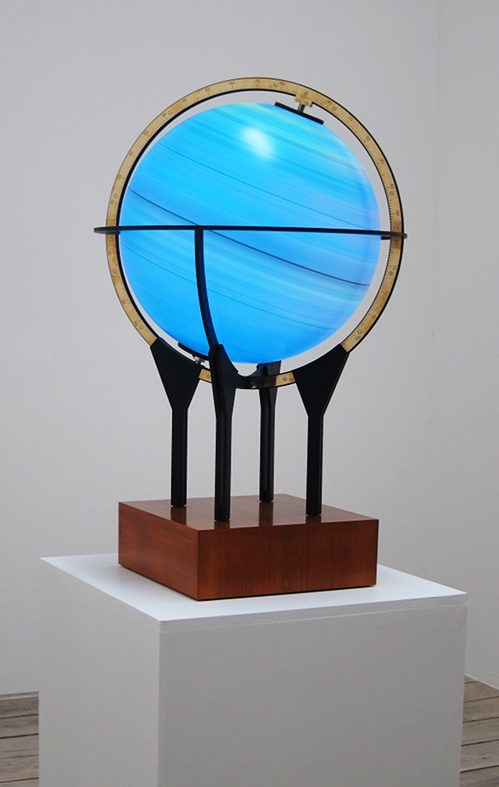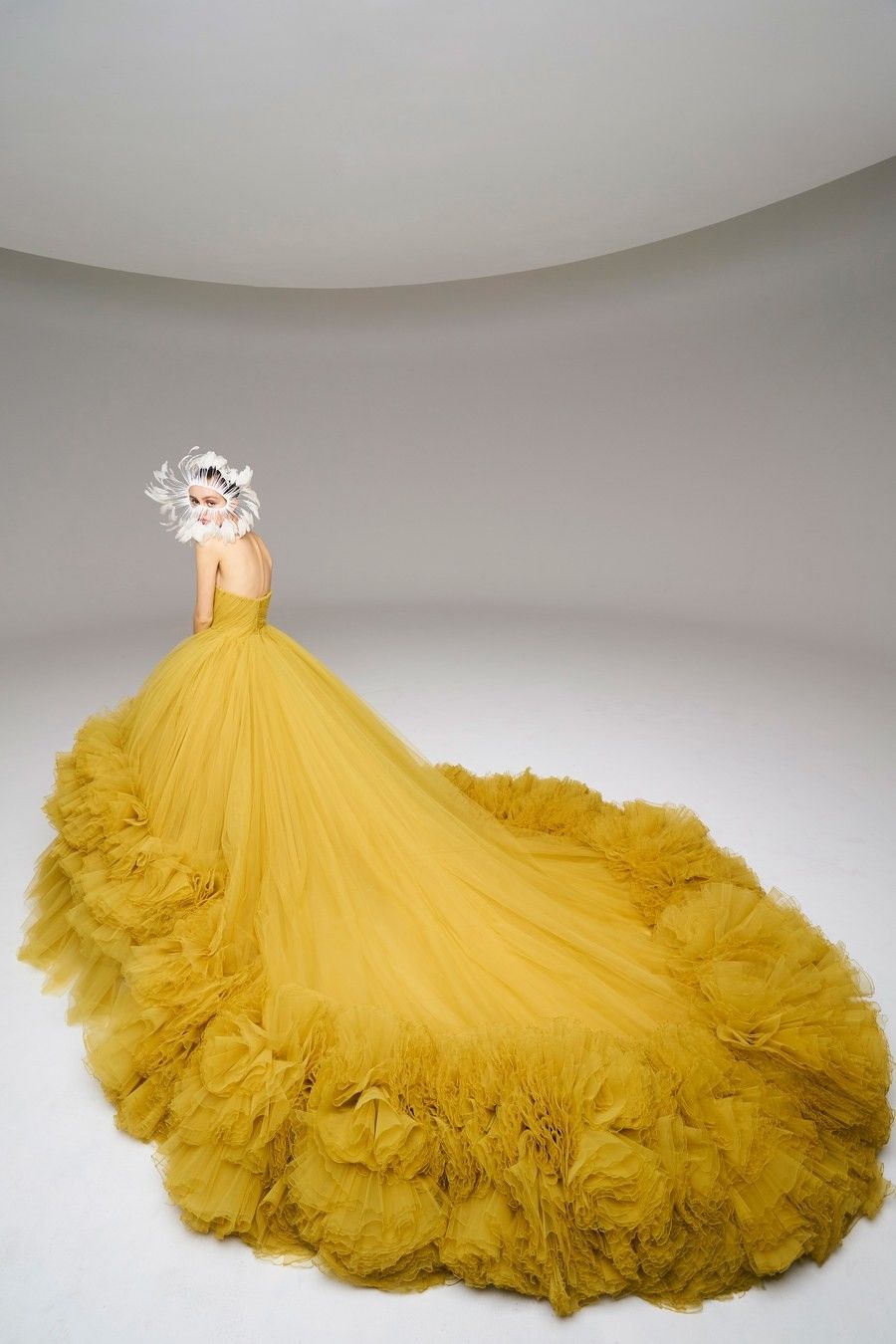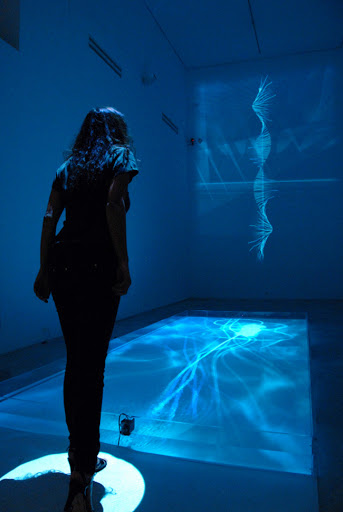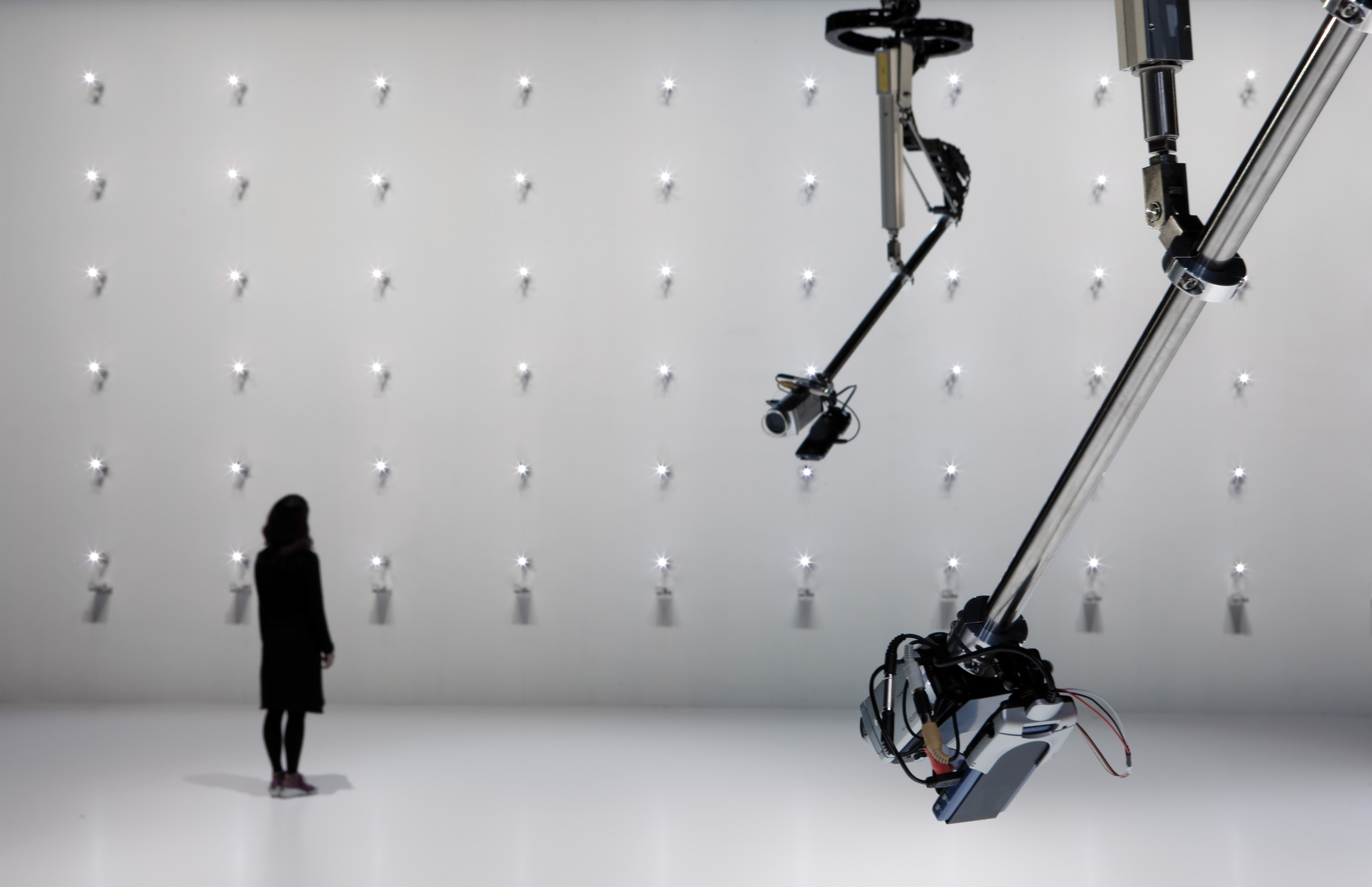


Olafur Eliasson
DET LYTTENDE SPEJL
Visitors to DNV-Gødstrup, a new hospital near Herning, Denmark, are greeted at the main entrance by an airy, round pavilion. Two curved pipes, crossing one another perpendicularly, hold a large disc aloft at a slight angle. The reflective underside of the disc mirrors the semicircular pipes, creating the illusion of two complete circles passing through the ceiling and rising into an imaginary space above. As visitors enter the pavilion, they can gaze up at their own reflections in the mirror and see themselves incorporated, upside down, into the artwork, embraced within the globe drawn by the pipes. The tilt of the ceiling allows the reflections to be seen from the outside. As the viewer moves towards and around the pavilion, the rings appear to shift in shape, changing from ellipses to circles and back again.

Amigo & Amigo
Affinity
Affinity is an immersive interactive light and sound installation inspired by the human brain. Each light globe represented a memory, as people approached Affinity different memories could be heard. When people touched the memory a light would trigger, the longer they touched the further their light would travel throughout the sculpture. Affinity features 62 different colour combinations and 112 points of interaction.

Lyota Yagi
Sound Sphere
An installation consisting of cassette tape wound around a spherical object and a device to play its sound. There is no beginning or end to the tape; rather, a small motor randomly moves the sphere as it sits atop the player, producing noise. The work varies in scale from installation to installation. Varying sizes of globes are covered with a length of time that is proportional to their surface area. When linear time is wound around a sphere, it is deprived of the relationship between place and time, and thus also loses its meaning (or in other words, causes meaning to arise).

Tundra
Nomad
Inspired by the concept of digital nomads of 21st-century and based on various pieces and algorithms from TUNDRA’s previous highly acclaimed audio-visual installations premiered across the globe from USA to China, NOMAD brings the polar atmosphere of different TUNDRA site-specific installations into a randomly changing sequence of visual themes and patterns triggered by live-performed sound.

Claire Williams
Zoryas
Six formes reposent au centre d’un grand disque plat. L’une rappelle les morceaux de silice amorphe produits par l’impact de la foudre sur le sable, les autres semblent pareilles à des méduses, coraux ou algues qui peupleraient des fonds marins dont on ne sait rien. Chacune d’elle est emplie d’une matière-énergie de teinte et de structure à nulle autre égale. Les six formes sont toutes différentes mais elles appartiennent sans aucun doute à la même classe d’objet, la même catégorie de choses. Aux physiciens, elles rappellent les tubes utilisés par Heinrich Geissler pour expérimenter sur le comportement de certains gaz lorsqu’ils sont traversés par des courants électriques. A ceux qui fréquentent les boutiques des musées de sciences, elles rappellent les globes luminescents qui réagissent aux toucher. Aux explorateur des hautes latitudes, elles rappellent les aurores boréales. Elles sont à la fois tout cela et rien de cela.

Liu Wa
2020 Got Me Like
As COVID-19 speeds around the world and continues to shut down more cities, people begin to consume Internet culture in order to escape the apocalyptic anxiety in 2020, allowing Internet memes to go viral across the globe. Built upon social media, this work merges everyday sentiments with classical movie scenes to deconstruct the common imagination of “apocalypse” in entertainment industry. The video also incorporates the artist’s footage during protests, turning memes into public commentary and political satire. In this eventful year, meme does more than hijacking and decontextualizing meanings, it has become a form of silent revolt against the absurd.

Lawrence Malstaf
FILE SAO PAULO 2017
OVERVIEW
Astronauts who were able to observe planet Earth from outer space for the first time, all experienced a strong emotional reaction later called the overview effect. A euphoric feeling of oneness with the planet and all living beings as a collective biotope where ‘my molecules are yours’ and vice versa and individuality seems an illusion.
The Overview-installation consists of a motorized video screen that can slowly pan, tilt and lift. The screen is 3m x 4m wide and has LED light on the backside. An abstracted globe is projected on the front.

Fayçal Baghriche
Souvenir
Being self-lighted, at the same time that it rotates on its own axis, the object distorts that which it apparently seeks to represent. Therefore, the presence of an inner light, associated with the rapid movement produced by the globe’s motorization, is responsible for abstracting any border line. By fostering the internal luminosity of a planet, which is pure darkness, the work relegates the value of representation to a second level and gives rise to a set of ideas disconnected from the real. In this sense, Souvenir is a means of reconsidering in what way the demarcations that define the geopolitical scenario of this tiny globe are lost in the Earth’s infinite rotativity.

Giambattista Valli
Giambattista Valli, a leading and established name in the worldwide fashion scene, brought a new approach and meaning to luxury and beauty that attracted a universe of a young, modern and international generation of highly glamorous and sophisticated women from around the globe and has been praised by celebrities and fashion lovers

ingo gunther
exosphere
The Exosphere has a diameter of 12 m (39’4″), weighs 4.5 tons, and relates to the Earth at a scale of 1:1,000,000. Its blue LED display indicates the geographic location of Wolfsburg, local temperature and time (supplied by the Atomic clock). It is positioned where Wolfsburg would be on this globe, assuming that the bottom of the globe is North and the vertical red display represents the position of the international dateline.
Field of Globes is a permanent installation of ninety World Processor globes. These spheres are readymade acrylic globes altered by the artist to visualize data on a variety of topics. This data comes from myriad sources, including the United Nations, the Organization for Economic Cooperation and Development, and other organizations.

NAZIHA MESTAOUI AND YACINE AIT KACI
NAZIHA MESTAOUI (1975 – april 29th,2020)
HOMAGE
R.I.P
Electronic Shadow
H2O
File Festival
Naziha Mestaoui, artist and architect, lives and works in Paris. She is pioneer in the art of the digital age, and recognized as inventor of realtime 3D Video Mapping, a patented technique at the crossroads of spatial and imagistic art.
She exhibits her artworks across the globe: MOMA in New York, Centre Georges Pompidou in Paris, the Museum of Photography in Tokyo, the Contemporary Art Biennale in Sevilla, Sao Paulo’s SESI (File Festival), Shanghai’s MOCA

Joe Diebes
Oyster
oyster is a new opera (in progress) about a surprising precursor to last.fm and Pandora. In the 1960’s, renowned American folklorist Alan Lomax developed a wildly ambitious system called cantometrics for coding and analyzing folk songs from every corner of the world. The opera is structured as a public lecture of Alan Lomax’s folk song analysis as demonstrated by four singers, who embody the IBM360 mainframe computer used to correlate his vast amounts of data. Working with the BOTCH vocal ensemble, I am reconstructing the folksong styles from regions as disparate as Bali, West Africa, and Central America using only the data from Lomax’s study. Things like melodic complexity, vocal blend, and nasality, are adjusted by the singers as they circumnavigate the globe. This data vocalization is further mediated by the ensemble’s distinctive extended vocal techniques, and is accompanied by a film narrative that unravels connections between cybernetics, surrealism and ethnography. The film also features a wide range of material drawn from the Alan Lomax archive at The Library of Congress.
.
oyster will be performed by BOTCH ensemble: Christina Campanella, Michael Chinworth, John Rose, and Saori Tsukada

chiharu shiota
تشيهارو شيوتا
千春盐田
צ’ילהארו יוטה
치하루 시오타
塩田千春
ТИХАРУ СИОТА
the key in the hand
The installation seeks to explore the notion of memory, using tens of thousands of keys collected from people across the globe in its realization. “Keys are familiar and very valuable things that protect important people and spaces in our lives. They also inspire us to open the door to unknown worlds” shiota explains.

CERN
Globe of Science and Innovation
History of the universe
Did you know that the matter in your body is billions of years old?
According to most astrophysicists, all the matter found in the universe today — including the matter in people, plants, animals, the earth, stars, and galaxies — was created at the very first moment of time, thought to be about 13 billion years ago.
The universe began, scientists believe, with every speck of its energy jammed into a very tiny point. This extremely dense point exploded with unimaginable force, creating matter and propelling it outward to make the billions of galaxies of our vast universe. Astrophysicists dubbed this titanic explosion the Big Bang.
The Big Bang was like no explosion you might witness on earth today. For instance, a hydrogen bomb explosion, whose center registers approximately 100 million degrees Celsius, moves through the air at about 300 meters per second. In contrast, cosmologists believe the Big Bang flung energy in all directions at the speed of light (300,000,000 meters per second, a million times faster than the H-bomb) and estimate that the temperature of the entire universe was 1000 trillion degrees Celsius at just a tiny fraction of a second after the explosion. Even the cores of the hottest stars in today’s universe are much cooler than that.
There’s another important quality of the Big Bang that makes it unique. While an explosion of a man-made bomb expands through air, the Big Bang did not expand through anything. That’s because there was no space to expand through at the beginning of time. Rather, physicists believe the Big Bang created and stretched space itself, expanding the universe.

SUSANA SOARES
Insects au Gratin
Das Projekt sucht nach neuen Wegen, Insekten zu konsumieren, und diskutiert die Nährstoff- und Umweltaspekte von Insekten als menschliche Nahrung. Durch die Kombination von Entomophagie mit neuen 3D-Technologien für den Lebensmitteldruck ermutigt Insects au gratin die Menschen, über nachhaltigere Ernährungsweisen nachzudenken. “Warum nicht Insekten essen?” Dies war die Frage, die Vincent Holt 1885 stellte, als er im St. Paul Daily Globe vorschlug, dass Insekten als primäre Nahrungsquelle für den Menschen dienen könnten. Während die Idee von den Viktorianern abgelehnt wurde, haben Insekten an vielen Orten auf der Welt eine lange Geschichte als Nahrung. Wie Holt betonte, sind Insekten alle Gemüsefresser, sauber, schmackhaft, gesund und in ihrer Fütterung entschieden spezifischer als wir ‘. Sie sind auch enorm effizient bei der Umwandlung von Vegetation in essbares Protein. 100 kg Futter produzieren 40 kg Grillen, aber nur 10 kg Rindfleisch. Insekten Au Gratin sucht nach neuen Wegen, Insekten zu verzehren, und diskutiert die Nährstoff- und Umweltaspekte von Insekten als menschliche Nahrung. Einer der Aspekte, der Menschen davon abhält, Insekten zu essen, hat nicht nur mit dem kulturellen Hintergrund zu tun, sondern auch mit der Ästhetik der Gerichte selbst.

Nives Widauer
Global Globes
“..In Global Globes (2011), Widauer has collected over 290 globes of all different sizes, years of manufacture and locations and geopolitical variation, putting them together into a mosaic-like map of the world. Global Globes is conceptually designed by the artist as a floor installation, so that the best place to see it is via a live circuit camera installed high above the ‘globe world map’..”

SEIKO MIKAMI
Desire of Codes
This interactive installation consisting of three parts is set up in YCAM’s Studio A, a space that is normally used for theatre performances.
A large number of devices resembling tentacles with built-in small cameras are placed across a huge wall (Part 1), while six robotic “search arms” equipped with cameras and projectors are suspended from the ceiling (Part 2). Each device senses with insect-like wriggling movements the positions and movements of visitors, and turns toward detected persons in order to observe their actions. In addition, a giant round-shaped screen that looks like an insect’s compound eye is installed in the back of the exhibition space (Part 3). Visual data transmitted from each camera, along with footage recorded by surveillance cameras installed at various places around the world, are stored in a central database, and ultimately projected in complex images mixing elements of past and present, the venue itself and points around the globe, onto the screen. The compound eye visualizes a new reality in which fragmentary aspects of space and time are recombined, while the visitor’s position as a subject of expression and surveillance at once indicates the new appearances of human corporeality and desire.

HEHE – HELEN EVANS AND HEIKI HANSEN
Domestic catastrophe Nº3: La Planete Laboratoire
in collaboration with Dr. Jean-Marc Chomaz, Ladhyx, École Polytechnique
An aquarium containing a domestic globe, a motor to turn the globe and electronic valve or drip feed which releases a fluoresceine tracing dye onto the sphere. As the sphere turns, the green dye wraps itself around the sphere, enveloping it in what appears to be a thin gas or atmosphere that surrounds the planet Earth. The difference between emissions and atmosphere, the ‘man-influenced’ and the ‘natural’ climate cannot be easily defined.

THOMPSON HARRELL
The Color Project
MPC New York und ich wurden eingeladen, ein generatives Kunstwerk für den hochkarätigen Start des Media Centers beizusteuern. ‘The Color Project’ ist Teil eines fortlaufenden F & E-Konzepts, das von mir und MPC Digital entwickelt wurde. Das Startstück bleibt als eine von fünf permanenten Installationen im Zentrum zu sehen. Das Made in NY Media Center von IFP bringt Innovatoren aus verschiedenen Kreativbranchen und aus allen Regionen zusammen widmet sich der Definition und Förderung der Zukunft des digitalen Geschichtenerzählens. Der Raum befähigt Künstler, indem er sie mit Ressourcen und Publikum verbindet, um ihre Kunst weiterzuentwickeln. Das Farbprojekt konzentriert sich auf die Erforschung von Erzählungen anhand von Farben, Linien und Formen, die in geografischen Satellitenbildern zu finden sind. Diese Implementierung des Projekts hebt die Schauplätze vieler Filme hervor, die von IFP verfochten wurden. Die formalen Motive jedes Filmortes werden in Form eines Rasters von 162 Globen untersucht. In wunderschöner Synchronizität taucht jede Ansicht zuerst aus dem Weltraum auf und bleibt bei einer einzelnen Farbe in der Landschaft stehen, wodurch ein ortsspezifisches Mosaik entsteht. Das Stück springt von einem Ort zum nächsten und zeigt den Charakter von Bogotá, Kolumbien (Maria voller Anmut), Cleveland, New York City, Florida (Fremder als das Paradies), Vietnam und Virginia (Der gefährlichste Mann in Amerika: Daniel Ellsberg) und die Pentagon Papers), während sie gleichzeitig auf den Kontrast zwischen den Standorten aufmerksam machen. Das Stück verwendet Google Earth und eine benutzerdefinierte Software zeichnet programmgesteuert die geografischen Merkmale jedes Standorts auf, die auf einer beeindruckenden Wand aus 27 HD-Bildschirmen dargestellt werden.

ANNA WILKINSON
Sculptural Simulacrum
“..Inspiration for this project comes from digital sculpture that created by sculptors who use specialized software to create their work.
In my literature review, I was fascinated to learn how much engineering and math are often involved in digital sculpture and to learn that the process of digital sculpturing has many similarities to pattern making which also relies heavily on mathematic, angles, and precise measurements…” “…One of the most inspiring digital sculptors for me was “Basheba Grossman”. I enjoyed many of his pieces, but was especially inspired from his digitally created bronze knots. In addition to the precise geometry of the knot sculptures, something which, even with the naked eye, it’s apparent that the knots are precise symmetrical pieces. What is also fascinating about the knots is that they exist simultaneously as different shapes that still occupy a single space! Collectively the knots form a sphere, or suggest a cycle or globe, yet the components of the knots are often more like bent stretching disc or arms. The knots have no visible foundation, it is impossible to see where the “starting point” and the “ending point” or even the edges of the sculpture exist..”

DELORME
Eartha
Eartha, the world’s largest rotating and revolving globe, is located within the headquarters of the DeLorme mapping corporation in Yarmouth, Maine. The globe weighs approximately 5,600 pounds (2,500 kg), and has a diameter of over 41 feet (12.5 m). This gives it a scale of 1:1,000,000, on which one inch represents 16 miles (26 km), one millimeter represents one kilometer. As with most globes, it’s mounted at a 23.5 degree angle, the same axial tilt as the Earth itself; thus the equator is diagonal to the floor. It uses a cantilever mount with two motors, and simulates one day’s revolution and rotation every hour, though it is possible for the motors to fully rotate the globe in as little as one minute.


LIDA ABDUL
ليدا عبدول
What We Saw Upon Awakening
In my work, I try to juxtapose the space of politics with the space of reverie, almost absurdity, the space of shelter with that of the desert; in all of this I try to perform the ‘blank spaces’ that are formed when everything is taken away from people. How do we come face to face with ‘nothing’ with ‘emptiness’ where there was something earlier? I was a refugee myself for a few years, moving from one country to another, knowing full well that at every juncture I was a guest who at any moment might to asked to leave. The refugee’s world is a portable one, allowing for easy movement between borders. It is one that can be taken away as easily as it was given: provisionally and with a little anxiety on the part of the host.
Sometimes people say, I am post-identity, post-nation, etc.. I don’t know what this means. For me the most difficult thing is precisely to go past the memory of an event; my works are the forms of my failed attempts to, what others call, transcend. But what? For me art is always a petition for another world , a momentary shattering of what is comfortable so that we become more sophisticated in reclaiming the present. The new wandering souls of the globe, the new global refuseniks —stubborn, weak, persecuted, strong—will continue to make art as long as people believe in easy solutions and closures of the most banal kinds.